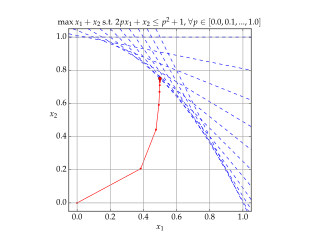Quadratic programming (QP) is the process of solving a special type of mathematical optimization problem—specifically, a quadratic optimization problem, that is, the problem of optimizing a quadratic function of several variables subject to linear constraints on these variables. Quadratic programming is a particular type of nonlinear programming.

Linear programming is a method to achieve the best outcome in a mathematical model whose requirements are represented by linear relationships. Linear programming is a special case of mathematical programming.
In the mathematical field of graph theory the Hamiltonian path problem and the Hamiltonian cycle problem are problems of determining whether a Hamiltonian path or a Hamiltonian cycle exists in a given graph. Both problems are NP-complete.
In mathematical optimization, Dantzig's simplex algorithm is a popular algorithm for linear programming.
In mathematical optimization, a problem is defined using an objective function to minimize or maximize, and a set of constraints

Interior-point methods are a certain class of algorithms that solve linear and nonlinear convex optimization problems.
In mathematical optimization and related fields, relaxation is a modeling strategy. A relaxation is an approximation of a difficult problem by a nearby problem that is easier to solve. A solution of the relaxed problem provides information about the original problem.
In numerical mathematics, relaxation methods are iterative methods for solving systems of equations, including nonlinear systems.
In mathematical optimization, Bland's rule is an algorithmic refinement of the simplex method for linear optimization.
A complementarity problem is a type of mathematical optimization problem. It is the problem of optimizing a function of two vector variables subject to certain requirements (constraints) which include: that the inner product of the two vectors must equal zero, i.e. they are orthogonal. In particular for finite-dimensional real vector spaces this means that, if one has vectors X and Y with all nonnegative components, then for each pair of components xi and yi one of the pair must be zero, hence the name complementarity. e.g. X = (1, 0) and Y = (0, 2) are complementary, but X = (1, 1) and Y = (2, 0) are not. A complementarity problem is a special case of a variational inequality.
In mathematical optimization, linear-fractional programming (LFP) is a generalization of linear programming (LP). Whereas the objective function in a linear program is a linear function, the objective function in a linear-fractional program is a ratio of two linear functions. A linear program can be regarded as a special case of a linear-fractional program in which the denominator is the constant function one.
In mathematical optimization theory, the mixed linear complementarity problem, often abbreviated as MLCP or LMCP, is a generalization of the linear complementarity problem to include free variables.
In applied mathematics, a nonlinear complementarity problem (NCP) with respect to a mapping ƒ : Rn → Rn, denoted by NCPƒ, is to find a vector x ∈ Rn such that

In mathematical optimization, the criss-cross algorithm is any of a family of algorithms for linear programming. Variants of the criss-cross algorithm also solve more general problems with linear inequality constraints and nonlinear objective functions; there are criss-cross algorithms for linear-fractional programming problems, quadratic-programming problems, and linear complementarity problems.

The Klee–Minty cube or Klee–Minty polytope is a unit hypercube of variable dimension whose corners have been perturbed. Klee and Minty demonstrated that George Dantzig's simplex algorithm has poor worst-case performance when initialized at one corner of their "squashed cube".
Artelys Knitro is a commercial software package for solving large scale nonlinear mathematical optimization problems.

In mathematical optimization, affine scaling is an algorithm for solving linear programming problems. Specifically, it is an interior point method, discovered by Soviet mathematician I. I. Dikin in 1967 and reinvented in the U.S. in the mid-1980s.

Richard W. Cottle is an American mathematician. He was a professor of Management Science and Engineering. Cottle started being an Acting Assistant Professor of Industry Engineering in 1996 and retired in 2005. He is notable for his work on mathematics programming, “Nonlinear programs”, the proposal of linear complementarity problem, and fields of operation research.

The International Standard Book Number (ISBN) is a numeric commercial book identifier which is intended to be unique. Publishers purchase ISBNs from an affiliate of the International ISBN Agency.
Mathematical Reviews is a journal published by the American Mathematical Society (AMS) that contains brief synopses, and in some cases evaluations, of many articles in mathematics, statistics, and theoretical computer science. The AMS also publishes an associated online bibliographic database called MathSciNet which contains an electronic version of Mathematical Reviews and additionally contains citation information for over 3.5 million items as of 2018.







